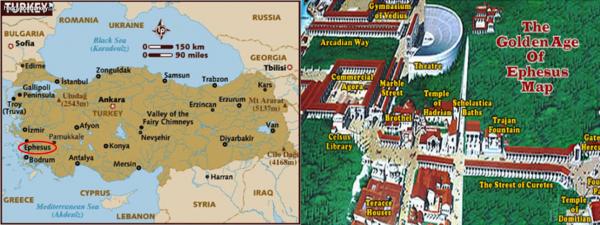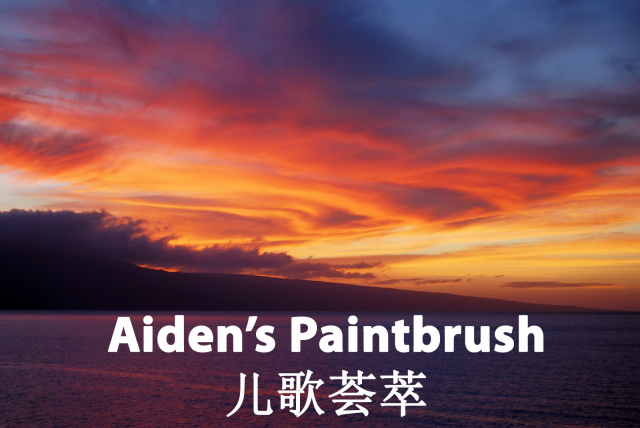Ephesus, the Ancient Trading Turkey(土耳其以弗所·古代贸易中心)
2015-06-18

【Aiden in English】
In ancient times, Ephesus in Turkey stretched 4.3 miles/7 kilometers and bustled with more than 300,000 people. As a central trading post with the Middle East, its archaeological sites were rich in Greek and Roman history. Some of the fascinating buildings of the time were the ruined Temple of Artemis, the sacred House of the Virgin Mary, and the grand Basilica of St. John right up against the Aegean Sea.
Ephesus wasn't a grand metropolis compared to one of the world's most enormous jigsaw puzzles approximately 3,000 years ago. Ephesus was invaded at its most significant peak for many reasons, too. First of all, there was Christianity. It was changing the population's ways of thinking and having the House of the Virgin Mary built a few miles away from where Mary was brought here by the Apostle John after the Resurrection of Christ, and lived out her days. It was quickly spreading like wildfire. Word was fast to go around. The following reason was the nearby Cayster River that flowed into the Aegean Sea. Ephesus was a hub of trade overseas. Returning to my 4th-grade science kit, I've learned that a river carries bits of land and can plop them where it feels fit. The bits of land are made up of sand, rocks, and very fertile soil. The silt was dumped in the river mouth near the entrance to the Aegean Sea. More and more land came to fill here, forming a delta. It had marsh-like conditions, and the port, once connected to the sea, was now on dry land. No ships in or out meant no trade. Back in a simpler time, no trade meant no wealth, and no wealth meant no power. Finally, Ephesus was next to many conquering armies. Because it's fertile, many thought Ephesus was worth fighting for.
Ephesus' host goddess was Artemis, the Greek goddess of the hunt. The Temple of Artemis was built in her honor and became Earth's most significant architectural structure in 800 BC. Unfortunately, an invading army destroyed it, which is a shame since now it's well-known as one of the Seven Wonders of the Ancient World. The place was ideal for a city in a valley with a river nearby. Nevertheless, that wasn't all. The architecture was top-notch, fending off rainwater and earthquakes. Ephesus had an extensive underground system of pipes that carried rainwater. Brutal, lethal, melting, incinerating, piercing, blazing, X-ray-like sunshine was prevalent around 90% of the year. For the other ten, however, let's say not even the sky could hold its bladder forever. The pillars of the city needed strength against earthquakes as well, since the area was sitting near the meeting of two continental plates between Europe and Africa. The metal clamps secured the pillar to the ground for protection, and then the molten lead was poured over it to solidify it. It is the technique used now; we use concrete instead of lead. The advancements didn't just stop there. Ephesus demonstrated a sign of early recycling. When a block of marble ran out of use, it would be paved into the street. So, as I walked down the road, I was probably standing on one of the most expensive pathways ever made in the world. Talk about beautification.
The culture, technology, and architecture seem so new for a city so old. Although the life of Ephesians was different from ours, time can’t change certain things for man. It never had, and it never will.
【红霞译】
从前,土耳其古城以弗所“理想城”地域横亘四英里多/七公里长,人口高达三十多万,作为通往中东地区的贸易门户,城邦建设浓重地沿袭了古希腊和古罗马传统,在爱琴“波浪”海沿岸留下为数不少的名胜古迹,譬如:阿尔忒弥斯“女神”庙遗迹、圣母玛丽亚“慈爱”故居、圣约翰“神慈”大教堂。
如今以弗所已不再是三千年前的繁华都会,昌盛期间由于种种原因一直深受外部势力影响。首先在宗教上,基督教改变了人们的世界观,圣母玛丽亚故居就建在离市区仅有若干英里远的地方,据说玛丽亚在基督复活之后被耶稣十二门徒之一圣约翰带到这里直至魂归天堂,消息如野火春风,很快传遍世间各地。其次在地理上,基士特河流经以弗所附近汇入爱琴海,以弗所因此正好成为海运交通枢纽。早在小学四年级科普教育时就已提到,河水流动会带走陆生杂质,而这些由泥沙、碎石及沃土组成的陆生杂质沿河床随处沉积,爱琴海入海口处淤泥四溢,逐渐形成三角洲,出现类似沼泽一样的盐碱地。连接海湾的港口被陆地取代,船只无法行驶,海上贸易失去运作功能。回到古代那会儿,如果失去对外贸易交流,那么无异于掐断了本地经济命脉;倘若没有钱财收入,势必导致权力丧失。最后在政治上,以弗所屡经血火洗礼,因土地富饶而深陷战争泥潭。
以弗所的保护神是阿尔忒弥斯,即希腊神话中的狩猎女神。阿尔忒弥斯神庙是以弗所人为祭祀狩猎女神而建,号称公元前八百年间全球最雄伟的建筑,不幸的是它毁于战乱,真是奇天大耻,因为阿尔忒弥斯神庙算得上古代世界七大奇迹之一。这一带风水宝地,山谷间河流旁尤其适于建造城邦,然而除了自然优势之外,神庙在建筑水平上实属一流,既防水又抗震,并且地下设有管道系统,可以排放雨水。这里一年四季90%日子里,阳光歹毒致命烧心焦化火燎,如同X线穿透力强,剩下的10%则大雨滂沱,连老天爷都自惭形秽。以弗所石柱需要经得起地震考验,因为其所在地恰巧处在欧非大陆板块之间,为了增强稳定性,使用金属钳子才能将石柱牢牢固定在地基上,然后再浇筑溶化的铅液来提高防腐功效,直到今天我们仍在沿用这种技术,只不过改用钢筋混凝土而已。先进的创举绝非局限到此,以弗所还萌发回收想法,报废的大理石被拿来铺垫通道,所以当我漫步其上,没准正踩在迄今为止世界上最昂贵的马路,暂且不谈令人脚下生风的美感。
虽说以弗所是个古老的城邦,但无论在文化技术还是建筑工艺上都发展得相当前沿,那时人们的生活肯定跟现在有所不同,时代造就英雄,这是永远无法改变的事实,以前不会,将来恐怕也不可能。
Today in History(历史上的今天):
2015: Kusadasi, the Aegean Resort TUR(土耳其库萨达斯·爱琴海避暑胜地)
2015: Seljuk, the Sacred/Honored Place TUR(土耳其赛尔柱·神圣之地)
2014: Last Day of Fifth Grade(小学五年级最后一天)
2013: 学期评估(Year-End Evaluation)
 Ephesus, the Ancient Trading Center
Ephesus, the Ancient Trading Center
(以弗所·古代贸易中心)

Stone Carving of Gladiator (石刻·角斗士)
 Stone Carving of Capital (柱头石刻)
Stone Carving of Capital (柱头石刻)
 Corbel Carved w/ Acanthus Leaves
Corbel Carved w/ Acanthus Leaves
(莨苕叶雕花托臂)
 Statue of Nike (雕像·胜利女神)
Statue of Nike (雕像·胜利女神)
 Trajan Fountain from the Early 2nd Century AD
Trajan Fountain from the Early 2nd Century AD
(图拉真 "大胆" 喷泉·建于公元2世纪初)
 PADlio Fountain Noted for Its Extra-Wide & High Arch Supporting a Triangular Capital
PADlio Fountain Noted for Its Extra-Wide & High Arch Supporting a Triangular Capital
(波利奥喷泉·以其超宽高拱门和三角形柱头而闻名)
 Curetes Street (库瑞忒斯“年青人”街 06-18-2015)
Curetes Street (库瑞忒斯“年青人”街 06-18-2015)

Curetes Street (库瑞忒斯街 06-18-2015)
 Celsus Library, One of the Few Remaining Examples of the Great Libraries of the Ancient World Located in the Roman Empire
Celsus Library, One of the Few Remaining Examples of the Great Libraries of the Ancient World Located in the Roman Empire
(塞尔苏斯“崇高”图书馆·罗马帝国境内少数现存的古代世界大型图书馆之一)

Celsus Library, the 3rd Largest Library in the Greco-Roman World
(塞尔苏斯图书馆·古希腊罗马世界第三大图书馆 06-18-2015)
 Great Theatre from the 3rd Century BC w/ Marble Columns & the Remains of an Ancient Stage Capable of Holding 24,000 Spectators
Great Theatre from the 3rd Century BC w/ Marble Columns & the Remains of an Ancient Stage Capable of Holding 24,000 Spectators
(大剧院·建于公元前3世纪,有大理石柱和古代舞台遗迹,可容纳24,000名观众 06-18-2015)
 Marble Street @ the Archeological Excavations of Ephesus
Marble Street @ the Archeological Excavations of Ephesus
(以弗所考古发掘出来的大理石街 06-18-2015)
 Commercial Agora (商业集市 06-18-2015)
Commercial Agora (商业集市 06-18-2015)

Temple of Domitian, Built in the 1st Century AD & the 1st Structure in Athens Known to Be Dedicated to an Emperor
(图密善“驯服”神庙·建于公元1世纪,是已知的以弗所第一座献给皇帝的建筑)
 Temple of Hadrian Built Before 138 AD & Dedicated to EmperorADdrian
Temple of Hadrian Built Before 138 AD & Dedicated to EmperorADdrian
(哈德良“神色头发”神庙·在公元138年前建造,献给哈德良皇帝)
 Temple of Isis Dedicated Temple to the Ancient Egyptian Deity of Eternal Life & Resurrection
Temple of Isis Dedicated Temple to the Ancient Egyptian Deity of Eternal Life & Resurrection
(伊西斯“王座”神殿·供奉古埃及永生与复活女神)
 Terrace House about the Wealthy Life During the Roman Period
Terrace House about the Wealthy Life During the Roman Period
(露台房·展示了罗马时代富人生活)
 Explorer Lounge of Emerald Princess
Explorer Lounge of Emerald Princess
(“公主·翡翠”号游轮——探索者休息室 06-18-2015)

Pina Colada (椰林飘香鸡尾酒 06-18-2015)
 午餐:烤番茄奶油汤、牛肝菌蘑菇汁小牛肉馄饨、无糖半冷冻蓝莓冻、水煮梨和蓝纹奶酪块
午餐:烤番茄奶油汤、牛肝菌蘑菇汁小牛肉馄饨、无糖半冷冻蓝莓冻、水煮梨和蓝纹奶酪块
Crosslinks(相关博文):
